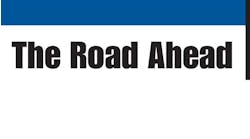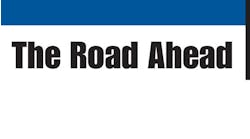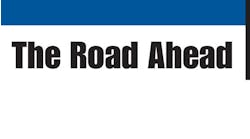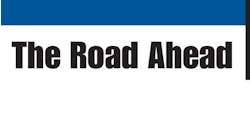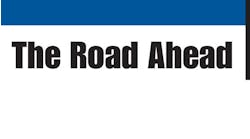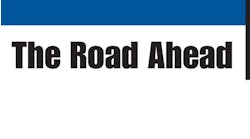It wouldn't be a normal economic-outlook presentation without the good ol' good news/bad news dichotomy.
William Strauss, senior economist and economic advisor for the Federal Reserve Bank of Chicago, gave the good news first.
“When you look around the world at how economies in Europe are doing, you see many struggling, and there are concerns about the survival of the Eurozone,” he said. “You have slowing growth in Asia. It appears that the US economy is the strongest economy in the world.”
Now for the bad news.
“The US economy appears to be the strongest economy in the world,” he said, waiting for the imaginary bah-dah-boom of the drummer's rim shot to finish his thought. “The kind of growth rates we're talking about are not that impressive.”
Strauss said the outlook is for the US economy to expand at a pace around trend in 2013 and above trend in 2014.
In the Great Recession, GDP fell by 4.6% — the longest decline and deepest drop since the 1930s. The Great Recession ended in June 2009, with the economy expanding by 2.6% over the past year. He said trend is 2% to 2.25%, which includes labor-force growth plus productivity growth.
The Chicago Fed National Activity Index's three-month average remains below zero.
“The economy continues to expand, but it's nothing to write home about,” he said. “Normally, we should be experiencing a much more aggressive recovery in expansion. It's like a tennis ball. Typically, the harder you throw it down, the higher up it bounces. Usually the deeper drop in a recession, the more robust the recovery. They tend not to buy big-ticket items, and that gets delayed and then released as they get confidence in their bonuses or the fact they're not as worried about losing their jobs. It's not happening this time. This time, it's different.”
Strauss said the liabilities side of the Fed's balance sheet shows a large amount of excess reserves.
“Before the financial crisis, our liabilities were all the greenbacks out there, all the cash in circulation — the required reserves financial institutions have to hold,” he said. “The housing bubble was one of the key things that started this. It's causing prices to fall and financial stress on many households. It is not like this economy is taking off and growing 5% to 6%, where people feel, ‘Oh, I have to expand. I have to buy a piece of equipment or I'll miss out on opportunities.’
“They're not being very aggressive in a market that is not rising rapidly. Profits are doing very well and the stock market has moved up from lower levels. As that pendulum swings towards greater willingness to lend and to borrow, as it's doing slowly, the financial sector has assets ready to be deployed. It's not like they have to raise new capital.”
Strauss said existing home prices fell by over 30%, but have begun to rise. The question is, how robust will the recovery be?
“I'm cautious,” he said. “I do believe the housing sector is in the recovery phase, but gains will be contained. Be very careful about being misled by statistics. In the housing sector, you will see double-digit gains. But when you look at the level of activity, it remains low.”
He said the stock market has improved since March 2009, but remains below previous levels. He said anybody celebrating with champagne is going to have a sour taste in their mouth because “you're celebrating that over the past six years, you got a 0% return on your investments.”
Strauss said GDP is forecast by the Fed to have grown slightly below trend in 2012 (1.9%) and to grow around trend in 2013 (2.2%) and somewhat above trend in 2014 (2.8%). He said he's a little more optimistic for 2013 (“maybe 2.75%”) and then over 3% for 2014 and 2015.
“Growth above trend is nice but not all that impressive,” he said.
Job picture still struggling
Employment fell by over 8.7 million jobs — 6% of the workforce — between December 2007 and February 2010. Since then, it has added just over 1.8 million jobs over the past 12 months.
“People will celebrate the fact that we had positive job growth, but it's not when you have labor-force growth of 1%,” he said. “Our estimate is that we have to create 100,000 jobs each month just to employ all the new entrants into the labor force. That's 1.2 million. If it takes 15 years to get all the jobs back, that's just too slow. According to Blue Chip, with growth at trend this year and just above next year, it's not going to improve the labor-market situation at a rapid pace anytime soon. By the end of this year, Blue Chip suspects we're looking at an unemployment rate of 7.5% by the end of the year, 7% by the end of 2014. In this context of slack in the economy, there is still capacity that we would like to take greater advantage of. “
Strauss said inflation has moderated, in large part due to the movement of oil prices. Adjusted for inflation, current oil prices are below the levels that existed 30 years ago.
Meanwhile, natural gas prices remain low.
“Normally, they move together,” he said. “But this time, as oil prices went higher, natural gas prices stayed lower. This is because of great supply shock, which is another one of the great positives going forward. We have a wonderful supply shop where we became the low-cost energy producer in the world that's going to foster additional activity — production of the chemical industry to our building plans. Your industry is going to be taking full advantage of that, as we're building out the infrastructure and putting in fueling stations in interstate stops.
“Expenditures on energy are below their historical average, so even though we have seen elevated prices for gasoline over the past year, people aren't spending as much on other energy needs, so it doesn't challenge our growth economy.”
Inflation is anticipated to rise 2% this year and 2.2% next year, according to the Blue Chip forecast.
“If they thought that inflation was just around corner, there would be an accelerated pattern, and we don't see it,” Strauss said.
The forecast calls for a gradual recovery in housing, with housing starts projected to be 948 this year and 1158 in 2014 after being 785 in 2012.
“Imbalances remain and need to be worked out,” he said. “Nationally, we still have a year's worth of inventory that needs to be worked off. That's down from two years a few years ago.”
Industrial output in manufacturing fell quite sharply during the recession, but has risen strongly over the past 42 months, averaging 5.5%, and has recovered 78.1% of the loss during the recession, Strauss said.
“Manufacturing has been a stellar sector in the recovery,” he said. “But they've only brought back 22% of the workers who lost jobs during the downturn. Blue Chip is predicting trend growth for this year and above-trend growth next year.
“Industrial production is forecast to rise at a trend pace this year and improve to above-trend in 2014.”
After rising by 13% in 2012, vehicle sales are predicted to rise 4% this year and next year.
“Vehicles are expected to be one of the better sectors, but it's because of people getting jobs and needing reliable vehicles, and given that the age of the fleet has increased quite a bit, these are reasonable forecasts,” he said.
“Net orders for heavy-duty and medium-duty trucks have been strengthening and are above their 20-year average. Trailer loads have improved over the past year and are growing at a decent clip just under 5%. You don't buy trucks just to take your kids to the picnic. You buy them to move freight, so freight growth will continue to happen. But you have to look at the levels. They're growing but still have a lot to move before they get back to more normal levels.”
He said monetary policy has been very aggressive, keeping the Federal Funds Rate near zero since December 2008. It is anticipated to remain very low over the forecast horizon.
“It's dependent on the evolution of the economy,” he said. “If it goes with the path we're talking about — moderate growth, labor markets improving slowly, inflation rates remaining low — the Fed does not see rates changing by end of this year or the end of next year,” Strauss said. “Maybe sometime in 2015, we'll begin to increase rates. When we do, do not get fooled by the media. They'll talk about the Fed ‘tightening policy.’ Right now, we are driving down the highway doing 100 mph. As we begin to raise rates, we are not touching the brakes. All we're doing is taking our foot off the accelerator. Are we slowing? Yes. But it's not until we get this vehicle down to 55 mph that we are going to be OK. A neutral rate is 4% to 4.5% for what our policy people think. It's not until we get to that level that we begin to talk about ‘tightening policy.’”
The asset side of the Fed's balance sheet has expanded in size and in composition, he said.
“People are worried that the Fed is ‘printing all this money,’ and it's going to be inflationary,” he said. “First of all, the Fed does not print money. Who prints money? The US treasury. We buy it from them. A $100 bill cost about 12.5 cents. Throughout our policies, the Fed creates money. Who is the Fed to be creating this money? How many have ever borrowed money to buy a house or take out a student loan? Every one of you are creating money in the economy. Every time the financial sector makes a loan, they are adding to the money supply of the economy. The money supply is about four times as much as the Fed's monetary base currently.”
